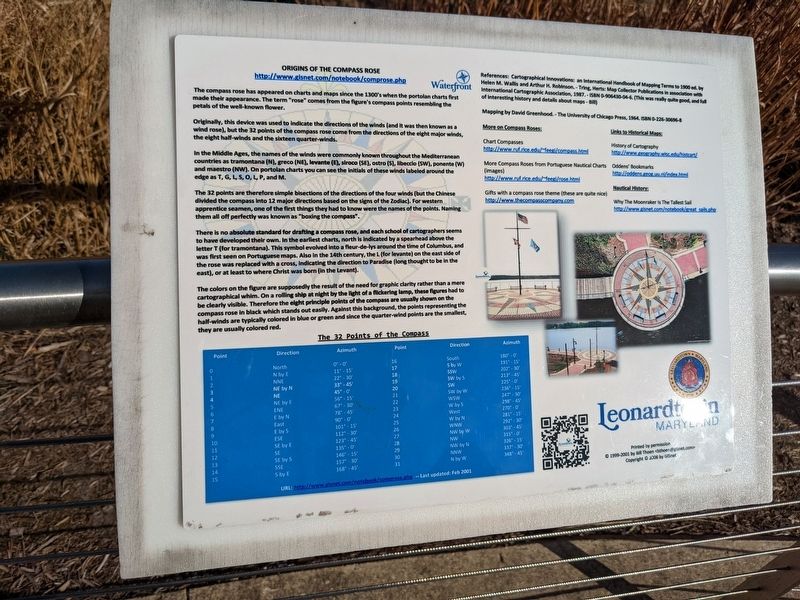Leonardtown in St. Mary's County, Maryland — The American Northeast (Mid-Atlantic)
Origins of the Compass Rose
http://www.gisnet.com/notebook/comprose.php
The compass rose has appeared on charts and maps since the 1300's when the portolan charts first made their appearance. The term "rose” comes from the figure's compass points resembling the petals of the well-known flower.
Originally, this device was used to indicate the directions of the winds (and it was then known as a wind rose), but the 32 points of the compass rose come from the directions of the eight major winds, the eight half-winds and the sixteen quarter-winds.
In the Middle Ages, the names of the winds were commonly known throughout the Mediterranean countries as tramontana (N), greco (NE), levante (E), siroco (SE), ostro (S), libeccio(SW), ponente (W), and maestro (NW). On portolan charts you can see the initials of these winds labeled around the edge as T, G, L, S, O, L, P, and M. The 32 points are therefore simple bisections of the directions of the four winds (but the Chinese divided the compass into 12 major directions based on the signs of the Zodiac). For western apprentice seamen, one of the first things they had to know were the names of the points. Naming them all off perfectly was known as "boxing the compass".
There is no absolute standard for drafting a compass rose, and each school of cartographers seems to have developed their own. In the earliest charts, north is indicated by a spearhead above the letter T (for tramontana). This symbol evolved into a fleur-de-lys around the time of Columbus, and was first seen on Portuguese maps. Also in the 14th century, the L (for levante) on the east side of the rose was replaced with a cross, indicating the direction to Paradise (long thought to be in the east), or at least to where Christ was born (in the Levant).
The colors on the figure are supposedly the result of the need for graphic clarity rather than a mere cartographical whim. On a rolling ship at night by the light of a flickering lamp, these figures had to be clearly visible. Therefore the eight principle points of the compass are usually shown on the compass rose in black which stands out easily. Against this background, the points representing the half-winds are typically colored in blue or green and since the quarter-wind points are the smallest, they are usually colored red.
Erected by Leonardtown, Maryland.
Topics. This historical marker is listed in these topic lists: Communications • Exploration • Parks & Recreational Areas • Waterways & Vessels.
Location. 38° 17.168′ N, 76° 38.331′ W. Marker is in Leonardtown, Maryland, in St. Mary's County. Marker can be reached from Washington Street. Touch for map. Marker is in this post office area: Leonardtown MD 20650, United States of America. Touch for directions.
Other nearby markers. At least 8 other markers are within walking distance of this marker. Leonardtown Wharf (within shouting distance of this marker); Invasion! (within shouting distance of this marker); Trade on the Waterfront (within shouting distance of this marker); Fun on the Waterfront (within shouting distance of this marker); Breton Bay (about 400 feet away, measured in a direct line); Steamboats at the Waterfront (about 400 feet away); The Legend of Moll Dyer (approx. ¼ mile away); War Comes to Breton Bay (approx. ¼ mile away). Touch for a list and map of all markers in Leonardtown.
Regarding Origins of the Compass Rose. References: Cartographical Innovations: an International Handbook of Mapping Terms to 1900 ed. By Helen M. Wallis and Arthur H. Robinson. - Tring, Herts: Map Collector Publications in association with Waterfront International Cartographic Association, 1987. - ISBN 0-906430-04-6. (This was really quite good, and full
of interesting history and details about maps - Bill)
Mapping by David Greenhood. - The University of Chicago Press, 1964. ISBN O-226-30696-8
Additional keywords. cartography
Credits. This page was last revised on August 7, 2023. It was originally submitted on December 4, 2021, by Sean C Bath of Silver Spring, Maryland. This page has been viewed 173 times since then and 24 times this year. Photo 1. submitted on December 4, 2021, by Sean C Bath of Silver Spring, Maryland. • Bill Pfingsten was the editor who published this page.
Editor’s want-list for this marker. A wide shot of the marker and its surroundings. • Can you help?
